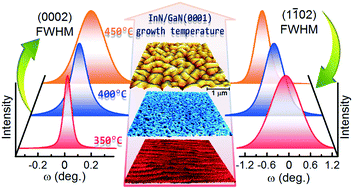Kinetically controlled transition from 2D nanostructured films to 3D multifaceted InN nanocrystals on GaN(0001)
Abstract
The evolution of morphological, structural, and luminescence properties of InN nanostructures grown on [0001]-oriented GaN substrates by plasma-assisted molecular beam epitaxy is reported. By varying the growth temperature, Tgr, by only 100 °C, a dramatic change in the apparent growth mechanism and the resulting surface morphology and nanoscale structure is observed. At the same time, there is a 30-fold enhancement in the photoluminescence intensity and an order of magnitude reduction in electron concentration. These changes result from a transition from a continuous 2D planar nanostructured film for the lower temperature growth characterized by high densities of edge type threading dislocations to 3D multifaceted nanocrystals with few observed dislocations for the higher temperature growth. This transition is correlated with an enhancement of the In adatom surface diffusivity due to the increased growth temperature and consequently with the dimensionality of the resulting nanostructures. Finally, it is demonstrated that understanding and implementation of the kinetic factors that influence the nucleation, growth, and crystal facet evolution during the initial stages of growth are crucial for the growth of 3D InN nanostructures or continuous layers with controllable properties.



 Please wait while we load your content...
Please wait while we load your content...